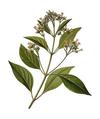What is Quinine? Bolivia for Kids
by Kricket
(BoliviaBella.com)

So today's blog is about medicine! Oh. Yay. -_- OK so I know you probably hate medicine (so do I) but this well-known medicine, used almost everywhere around the world, originated in Bolivia!
Quinine
Quinine (known as "quinina" in Bolivia) is a medicine that reduces fevers and acts as a pain killer. It has a bitter taste. It was first discovered by the Quechua tribes in Bolivia and Peru, and it was later shipped to Europe by the Jesuits. It is found in the bark of the cinchona tree (Image 1 Source). The Quechua people sometimes call it "kina kina".
Quinine was the first thing used to cure malaria in the 17th century until the 1940s when it was replaced by other drugs.
Quinine was being exported in massive amounts from Bolivia. However, the constant demand for quinine worldwide was causing extensive destruction of the forests without any effort to re-grow them. Because of this, merchants in 1873 began to grow the trees in easy-to-reach places. Thanks to this, there is now a large amount of these trees in Bolivia. Here's a picture of some real cinchona trees. They are a pretty invasive species and can overtake and cause the death of other plants.
A German family in La Paz, Bolivia has planted 300,000 of these trees on their property and most of the trees are ready for cutting in 1-2 years. Calculations show that a seven year old tree can produce 3 kilograms of bark and is higher in richness (of quinine) than older trees.
In the United States there is this ancient, classic TV show from the 1990's about a doctor/medicine woman living in the Old West. I wonder if they called her Dr. Quinn because she uses quinine to cure everything!
Many of the drugs we use to cure diseases come from forests and plants. Can you tell me other good reasons to preserve our forests?
Quinine
Quinine (known as "quinina" in Bolivia) is a medicine that reduces fevers and acts as a pain killer. It has a bitter taste. It was first discovered by the Quechua tribes in Bolivia and Peru, and it was later shipped to Europe by the Jesuits. It is found in the bark of the cinchona tree (Image 1 Source). The Quechua people sometimes call it "kina kina".
Quinine was the first thing used to cure malaria in the 17th century until the 1940s when it was replaced by other drugs.
Quinine was being exported in massive amounts from Bolivia. However, the constant demand for quinine worldwide was causing extensive destruction of the forests without any effort to re-grow them. Because of this, merchants in 1873 began to grow the trees in easy-to-reach places. Thanks to this, there is now a large amount of these trees in Bolivia. Here's a picture of some real cinchona trees. They are a pretty invasive species and can overtake and cause the death of other plants.
A German family in La Paz, Bolivia has planted 300,000 of these trees on their property and most of the trees are ready for cutting in 1-2 years. Calculations show that a seven year old tree can produce 3 kilograms of bark and is higher in richness (of quinine) than older trees.
In the United States there is this ancient, classic TV show from the 1990's about a doctor/medicine woman living in the Old West. I wonder if they called her Dr. Quinn because she uses quinine to cure everything!
Many of the drugs we use to cure diseases come from forests and plants. Can you tell me other good reasons to preserve our forests?
Submitted 2015-05-21



